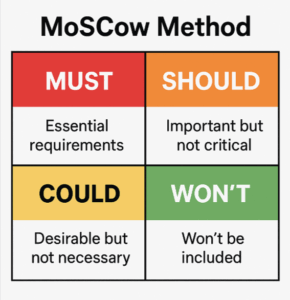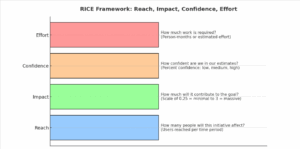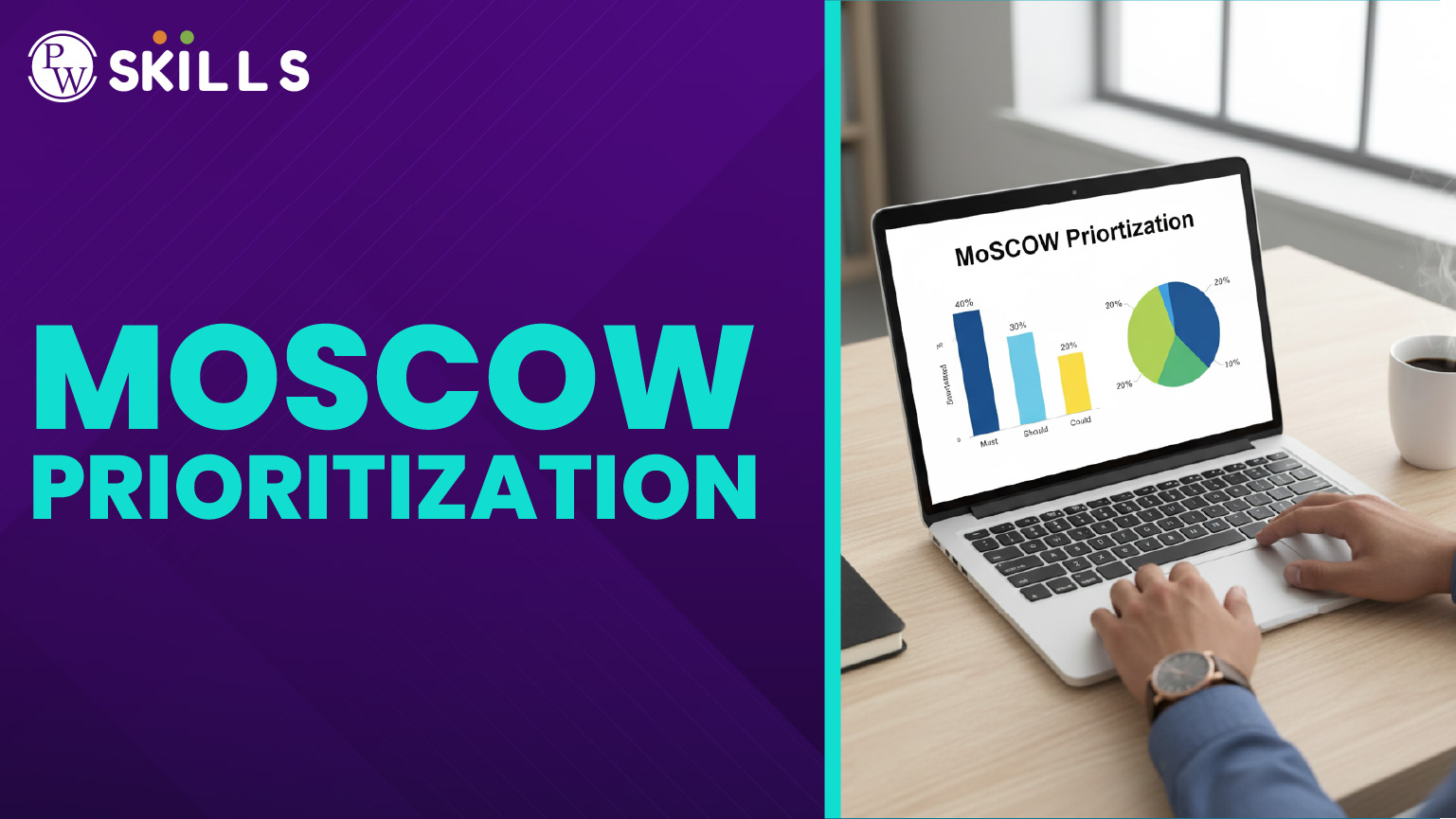MoSCoW prioritization system is super simple and a powerful way to solve this common problem. This method helps teams manage all their tasks and priorities clearly. MoSCoW prioritization sorts everything into four categories. These categories are Must, Should, Could, and Won’t.
- This brings crucial clarity to everyone involved.
- The clear language stops major confusion and conflicts later on.
- MoSCoW prioritization was created by an expert named Dai Clegg. He developed it while working at Oracle in the 1990s.
- The system works especially well for Agile projects. In these projects, requirements need to change fast.
The main job of MoSCoW prioritization is actually risk management. It sets clear expectations. MoSCoW prioritization ensures the project gets delivered on time. This happens even if unexpected problems pop up.
MoSCoW Method
MoSCoW method uses an acronym. This acronym stands for its four core categories. The small “O’s” are not categories themselves. They are just there to help you pronounce and remember the name easily.
This simple system forces teams to agree clearly on what truly matters right now. Using the MoSCoW method is all about setting clear expectations. It tells you what will be delivered in the current work timeframe. This clear setup is the power of MoSCoW prioritization.

M: Must Have (The Non-Negotiable Essentials)
These requirements are absolutely essential to the project. Without them, the project or product cannot be successful. It would be unusable. These tasks represent the minimum needed for a product to work.
- The Litmus Test for MoSCoW prioritization: You must ask this key question: “What happens if we do not deliver this item?”.
- If the project must stop, it is a Must-Have.
- If the item is critical for safety or legal reasons, it is a Must-Have.
- We must limit these tasks strictly for successful MoSCoW prioritization.
We need to be honest here. If everything is a Must, then nothing is. This ruins the whole point of MoSCoW prioritization.
S: Should Have (Important, but You Can Wait)
These tasks are highly important. They add major value to the final product. But they are not critical for the immediate success of the product. The product will still work without them right away.
- The Workaround Rule: Can the team find a temporary solution to work around the missing feature? If yes, it is a Should-Have.
- This workaround might be difficult or manual. But the core solution is still viable without the feature right away.
- This level of MoSCoW prioritization helps ensure high quality. It prevents project failure if the task is slightly delayed.
C: Could Have (The Wishlist Items)
These are the “nice-to-have” features. They might improve the user experience a lot. But they have very little impact if they are missing.
- The Safety Cushion: Could-Haves are the project’s main safety cushion.
- If time runs short, or problems appear, these are the first things you drop.
- Using this prioritization correctly means being ready to sacrifice these features. This happens if resources get low.
The Could-Haves are very important to manage risk as they give your team breathing room.
W: Won’t Have This Time (Deferred, Not Forgotten)
These are requirements that everyone agrees will not be delivered. They are simply deferred and are not forgotten forever.
- Future Focus: Won’t-Haves are recorded. They will be looked at again for a later release or cycle.
- Managing Expectations: Recording these items stops “feature creep”. This is when new ideas constantly sneak into the current schedule.
- This clear communication is a crucial step in honest MoSCoW prioritization. This helps your team focus on the current goals.
How to Build Your MoSCoW Prioritization Matrix?
For this prioritization to work, teams need discipline. The framework is designed to overcome vague methods. Methods like simple High/Medium/Low tags often cause indecision. The following five steps provide the structure you need for your MoSCoW prioritization matrix.

Step 1: Align Objectives and Define Scope
You must clearly define what success looks like. This is the very first step. If you skip this, your categories are meaningless.
- The entire team must understand the goals.
- All requirements must link back to your overall business goals.
- Define the exact time period you are prioritizing for. This is called a “time-box.”
Step 2: Establish the Golden Rules (Define Criteria)
This is the most critical step for proper MoSCoW prioritization. You need clear, objective criteria. This helps you place an item into a category. It cannot be based on personal feelings.
- Identify constraints: Criteria could be based on legal compliance. Maybe it is based on high user impact. It could also be based on team skill limitations.
- Manage disagreements: MoSCoW prioritization does not score things automatically. You must agree on how to settle disagreements before they happen.
- This objective system minimizes personal bias. This ensures consistency in your MoSCoW prioritization.
Step 3: Categorize Everything Together
Gather all your desired features. You should work with all key people. This includes designers, developers, and leaders.
- Go visual: Use a whiteboard with sticky notes. Or use a digital MoSCoW prioritization matrix template.
- Discuss each requirement one by one. Apply the MoSCoW rankings through open discussion.
- This shared effort builds consensus across all teams. This is a great benefit of MoSCoW prioritization.
Step 4: Challenge and Streamline Must-Haves
A frequent problem is “Must-Have Inflation”. This happens when stakeholders say everything is a “Must.” If your Must list is too long, the framework stops working.
- The Must-Have Audit: Review the Must-Have list carefully.
- Imagine the finished product without that specific feature. If the core function still works, the item is not a Must-Have.
- It must be moved down. This rigorous audit creates discipline in your MoSCoW prioritization process.
This is the toughest part of using MoSCoW prioritization correctly. Be strict with your choices.
Step 5: Execute and Communicate Expectations
The priorities are now clear and the team can focus. Start working on the Must-Haves first, then do the Should-Haves and finally, work on the Could-Haves.
- Resource Allocation: Nearly all early effort should go to the M’s. Once the core elements are done, resources can shift to the S’s.
- The outcome of this prioritization sets clear expectations. This is for the team and all stakeholders.
- Everyone knows what is guaranteed. They know what a flexible item is. Review these priorities often. This keeps your MoSCoW prioritization relevant.
MoSCoW Prioritization PDF Template
This prioritization workshops work best when they are visual. Seeing the requirements sorted helps everyone understand the differences instantly.
- Template Availability: You don’t have to build the tool from scratch. Many resources offer a ready-to-use MoSCoW prioritization pdf template you can download.
- Data Requirements: These MoSCoW prioritization pdf templates are great for gathering requirements. They ensure everyone uses the same format.
- Digital Matrix: For remote teams, online tools offer dedicated digital boards. These tools make visualizing the resulting MoSCoW prioritization matrix very simple.
The power of MoSCoW prioritization is clear. It forces objective decision-making over subjective wishes. By defining the scope and criteria first, you manage risk effectively.
Benefits of MoSCoW Prioritization
Using this framework changes how teams work. It’s a core component of the MoSCoW method.
- Clarity and Consensus: It gives the team a specific, shared vocabulary. It stops vague methods that lead to indecision.
- Setting Expectations: Stakeholders clearly understand what is guaranteed (M). This improves how you manage expectations greatly.
- Focus: MoSCoW prioritization ensures early efforts focus only on maximum impact—the Must-Haves. It gives a clear checklist.
- Flexibility: The system is flexible. This makes it perfect for development work where requirements change over time. MoSCoW prioritization adapts to change easily.
MoSCoW Prioritization Techniques
MoSCoW prioritization is quite a simple technique and proved to be highly effective. It is the discipline involved in the strict definition of what must-have items are. With strict adherence to this, one can ensure project delivery success. This is what Agile teams use all over the world for its clarity.
- Start Now: Snatch a MoSCoW Prioritization pdf template and give it a try.
- Outcomes: Learning MoSCoW prioritization will enable your team to become focus-centric. It would translate to more successful deliveries. It’s an important skill to have today. This is the essence of true MoSCoW prioritization.
Accelerate Your Career with PW Skills
Ready to move beyond basic prioritization and become a true Product Strategy leader? The PW Skills Product Management course is designed for rising stars who want practical, real-world skills. Learn how to master frameworks, conduct advanced market analysis, and lead product launches from concept to scale. Enroll today and transform your potential into expertise.
Dai Clegg invented it while working at Oracle. Yes, it works for any time-boxed project. Avoiding "Must-Have Inflation." Many tools offer PDF or digital templates online.FAQs
Who invented MoSCoW prioritization?
Can I use MoSCoW prioritization for personal tasks?
What is the biggest challenge of the MoSCoW method?
Where can I find a MoSCoW prioritization matrix template?

